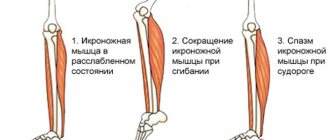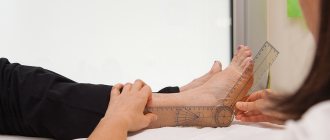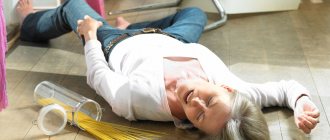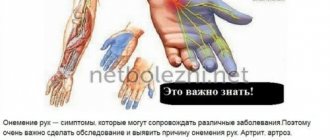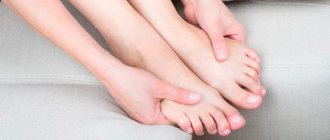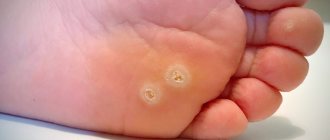A cramp is a sudden, involuntary, often painful contraction of a muscle. This happens to everyone from time to time: at night during sleep, during physical activity, and sometimes at rest. Spasm can occur in any part of the body - in the limbs, in the side, in the buttock, in the abdomen.
Often people have no idea why their muscles cramp. However, it is very important to find out the reasons for this, because a seizure can be both a physiological norm and a symptom of a serious disease. Let's look at this in detail.
Why do muscles cramp?
The reasons can be divided into two groups. The first includes those that do not have any underlying diseases. So, if the calf or gluteal muscles cramp in a dream, there is no physiological pathology in this. The seizure in this case is a parasomnia, that is, a phenomenon associated with sleep. Spasms that occur during increased physical activity also do not indicate an abnormality.
In other cases, such discomfort may be caused by:
- neurological disorders;
- compaction of muscle fibers against the background of physical inactivity;
- metabolic disorders;
- micronutrient deficiency;
- dehydration;
- poisoning (including cramps from a hangover).
There is also a disease called hypoparathyroidism. It is characterized by a convulsive syndrome that immediately affects muscle groups. This condition is caused by hypofunction of the parathyroid glands.
Types of seizures
If involuntary contraction of muscle fibers is caused by overexcitation of the cortical part of the brain, such convulsions are classified as epileptic. Non-epileptic ones are provoked by diseases of the central nervous system, imbalance of nutrients, and unfavorable external conditions.
Also, involuntary muscle contractions can be classified according to their nature:
- tonic – long-term, turning into a state of tension;
- myoclonic – short;
- clonic - jerky, cyclically repeating and alternating with relaxation.
Based on localization, these phenomena are divided into generalized and local. The former cover a significant part of the body (arms, legs, face, neck, side, torso, and sometimes extend to the respiratory tract). The latter occur in separate areas (for example, only in the back or only in the buttock).
Causes of seizures in different parts of the body
Muscle spasm in a specific area of the body is caused by specific factors. Most often it occurs in the legs. The culprits may be overexertion (including due to intense training), varicose veins and hypothermia.
It can cramp not only the calf muscle, but also the femoral and even gluteal muscles. Sometimes the unpleasant sensation will spread throughout the entire leg.
Abdominal cramps are also common because most abdominal organs are composed of highly contractile smooth muscle cells. Most often, the organs of the digestive system spasm. This is how the well-known abdominal pain occurs. In women, contractions of the uterus (during menstruation, pregnancy or gynecological diseases) cannot be ruled out.
Muscle spasms in the back indicate diseases of the musculoskeletal system. This could be osteochondrosis, intervertebral hernia, degenerative changes in the spine.
Exercises to Prevent Leg Pain
Stretching and strengthening your calf muscles will help prevent future pain. Before classes, you need to warm up your feet. It is better to do the exercises immediately after a hot shower.
Stand facing the wall, touch it with your palms. Place the toe of one foot towards the heel of the other. Leaning on the floor with the heel of your “back” leg and slightly raising your toes, bend the knee of your “front” limb. Lean against the wall, resting your palms on it. Stay in this position for 30 seconds.
Sit on the floor with your legs extended in front of you, toes pointing up. If you can reach your toes, grab them with your hands and pull them towards you, stretching the calf muscles. If you can’t reach your toes, you can hook your toes with a towel and pull on the ends for 30 seconds.
While sitting on a chair, raise and lower your heels. You can rise on tiptoes, or lower yourself, leaning on the back of a chair or table. Repeat each exercise 20 times, eventually increasing the number of repetitions to 40. If during the exercise you experience pain in the calf muscle, you should stop doing it.
Strengthening your lower leg helps relieve pain in the calf muscle. Place 1 kilogram of rice in a stocking and place it on your toes while sitting on a chair with your knees bent. Without lifting your heels off the floor, lean forward and pull your toes toward your shins. This exercise strengthens the finger extensor muscles, which reduces the load on the calf muscle.
Who usually experiences muscle cramps?
This trouble is familiar to everyone: men and women, children and the elderly, athletes and office workers. Only some people get to know her for natural reasons and rarely encounter her, while for others she becomes a frequent companion.
The risk group includes:
- children under 3 years of age who have experienced a rise in temperature above 38 degrees;
- elderly people suffering from vascular diseases and muscle atrophy;
- men engaged in heavy physical labor;
- athletes (football players, swimmers, runners);
- people who abuse alcohol and often experience hangovers;
Predisposes to muscle spasms and pregnancy. In mild cases, they are caused by a lack of vitamins due to changes in the body; in severe cases, they are caused by eclampsia.
Why do muscles cramp in pregnant women?
Carrying a child leads to significant changes in the body. In particular, metabolism is rebuilt. As a result, many expectant mothers are faced with magnesium deficiency, which is why cramps appear.
Pregnant women's legs are subject to greater stress due to weight gain. Hence the involuntary muscle contractions that occur in the evenings and at night. They can also be triggered by varicose veins, which often accompany hormonal changes.
Pregnant women often complain about back pain. The lumbar spine is under constant tension, forced to bend under the pressure of the uterus, so such sensations are normal. Therefore, expectant mothers are recommended to lie on their side to relieve the load on the spine.
Precursors of spasm and first aid
During sleep, they wake up from a cramp in their leg. When you lie down tired and your legs are heavy, then, most likely, a cramp attack will begin at night. Its onset is associated with increasing pain in the center of the calf. By nature it is burning, bursting. Swelling of the veins and swelling below the affected area are noted.
The arteries are compressed by a tense muscle, and the pulsation in them is not visible. You can notice changes in the calves by the pale skin and bluish tint. At the end of the attack, when the capillaries dilate, the leg becomes red.
Is it possible to run in the evening before bed?
You can help yourself by doing the following:
- Pull your foot towards you to stretch the cramped muscle.
- By gently massaging the calf, you can stop the spasm.
- The contracted limb rises upward, above the head.
- Pricking the calf several times with a pin will relieve the pain.
- Apply a cloth moistened with hot water to the affected area. You can add 1-2 drops of lavender or ginger oil to the water.
- Take your leg back, pressing the sole to the floor, the ground. For convenience, you need to rest your hands on the wall.
- Walk around the room, then take a warm bath.
Usually one of the actions stops the convulsive contraction. If there is no result, it is better to call an ambulance.
Diagnostic methods
If the muscles cramp regularly and the person experiences severe pain, it is necessary to consult a doctor. You should also be concerned if this symptom does not have a clear cause (it is not associated with training or staying in an uncomfortable position for a long time).
A common reason why people put off seeing a doctor is not knowing who can help with the problem. It’s better to start with a therapist, and he will give you a referral to a specialist:
- neurologist;
- gastroenterologist;
- phlebologist;
- gynecologist;
- endocrinologist.
After the initial examination, collecting complaints and receiving test results, the doctor will tell you what additional diagnostic methods will be needed. If your stomach cramps, you will be referred for an ultrasound, your back for an X-ray, your neck or calf muscles for a Doppler ultrasound of the blood vessels.
Taping
The gastrocnemius muscle is located on the back of the lower leg and consists of two heads that are parallel to each other. They smoothly transition into the Achilles tendon, which is very often injured. Given this structural structure, rehabilitation specialists at the Yusupov Hospital use only Y-tapes or lymph tape for taping the calf muscle. Y-tapes are more effective for sprained or torn ligaments. Lymph tape is used to accelerate the resorption of swelling and hematomas after bruises.
Tape is applied for pain in the calf muscle caused by contusion of muscle fibers, sprain of the calf muscle, tears of ligaments and muscle fibers. If the calf is torn or sprained, you can apply the tape to the calf muscle from bottom to top. In case of a bruise, lymph tape is applied from top to bottom. Before gluing the tape, the hair is shaved off and the surface of the shin is thoroughly wiped with alcohol.
The patient's position should help stretch the muscles of the lower leg - the foot should be in the direction towards itself. This can be done while lying on your stomach with your leg bent and your foot pointing towards you, or standing with your leg back and your heel on the floor.
The doctor selects the optimal tape length. It should correspond to the anatomical length of the calf muscle, taking into account the percentage of elongation of the middle part of the elastic band. The tape is placed from the plantar surface of the heel to the knee joint. The first and last 2-3 cm are glued without tension. When the calf is stretched, a tension of 20-30% is applied, and when there is a bruise, the tape is applied without any tension at all.
The rays of the tape should be located according to the location of the muscle fibers in the calf muscle - along the lower leg. If there are signs of injury to the Achilles tendon at the site of attachment to the calf muscle, apply a short tape perpendicular to the axis of the lower leg.
What treatment is possible
If diseases of the internal organs are identified that cause muscle cramps, then treatment of the underlying disease will eliminate the accompanying symptoms. Depending on the location, this may include medication, massage, or physical therapy.
Uncontrolled use of anticonvulsants is unacceptable. They are prescribed to patients with epilepsy. If a person sometimes experiences cramps in the gluteal muscle or neck, you should not abuse such medications.
First aid also depends on the location of the spasm. If it occurs in the leg (from the buttock to the foot), you need to rub the muscles, restore blood circulation in them, and warm them up. The back should be kept at rest. But with a belly it’s better not to take risks and call a doctor right away, especially for women who know about their pregnancy.
How to treat pain in the calf of the left or right leg
If you feel pain in your calf muscles, contact the Yusupov Hospital. Doctors will prescribe anti-edematous and anti-inflammatory treatment. After a comprehensive examination using x-rays, computed tomography and magnetic resonance imaging, blood and urine tests, a collegial decision will be made on treatment for the syndrome that causes pain in the calf muscles.
Severe cases of diseases that cause pain in the lower leg muscles are discussed by professors and doctors of the highest category at the Yusupov Hospital at a meeting of the expert council. Leading neurologists, rheumatologists, orthopedists, and rehabilitation specialists establish an accurate diagnosis and jointly develop tactics for further patient management. A comprehensive treatment is carried out aimed at eliminating the cause of pain, the mechanisms of development of the pathological process and relieving the pain syndrome. Therapy is carried out with effective drugs that have a minimal range of side effects.
After treatment, patients are offered a comprehensive rehabilitation program. It allows you to get all the necessary procedures at a stable price and save money. If you experience pain in the calf muscle, call the Yusupov Hospital, where the call center is open every day 24 hours a day, without days off or lunch breaks. Doctors provide emergency medical care around the clock.
What to do if a muscle is severely cramped
It is not always possible to easily endure such an attack by limiting yourself to rubbing the affected area. The pain can be unbearable. It can be removed with a sharp impulse.
For cramps due to a hangover, the patient should be placed in a horizontal position and the legs should be raised to reduce blood flow to the extremities. At the same time, it is important to make sure that we are not talking about an epileptic attack (they are not uncommon in alcohol intoxication).
In older people, involuntary muscle contractions are often a warning sign of stroke. Convulsions may give way to paralysis. Timely treatment is important here, so it is better to call an ambulance immediately.
What to do during a cramp
- Pull the toe of the leg on which the cramp has developed slightly towards you, then loosen the traction, then pull as much as possible. If the muscle spasm does not go away after this procedure, you need to stand on your leg and walk a little - these simple actions will speed up the blood flow in the limb and the cramp will most likely pass.
- Apply a light massage to the area of spontaneous muscle contraction from the periphery to the center.
- Massage your leg with warming ointment and knead it.
- Pinch the spasmed muscle or prick it with a needle.
- After the cramp has passed, you should lie down for a while with your legs elevated - in this position, the outflow of blood from the lower extremities will improve, which means that the likelihood of a repeat cramp will decrease.
Prevention
The best prevention of involuntary muscle contractions is moderate physical activity. Regular exercise helps keep your muscles under control. The tissues will not suffer from physical inactivity or sudden overload. This is equally beneficial for both men and women at any age.
A set of exercises to prevent cramps always includes stretching. It is useful to do it before bed so that unpleasant symptoms do not occur at rest.
Since muscles often cramp due to hypovitaminosis and lack of microelements, it is important to eat a balanced diet. If you cannot get them in sufficient quantities from food, you should additionally take vitamins B and E, as well as magnesium, calcium and potassium supplements. It is also important to drink enough fluids, because similar discomfort occurs due to dehydration.
Leg cramps at night - causes and treatment
14.10.2019
A cramp is a sudden sharp contraction of a muscle, accompanied by sharp, severe pain. Most often, muscle cramps can occur due to excessive stress on one or another part of the muscle. But very often, many people experience the appearance of muscle cramps during sleep. To eliminate the problem that has arisen, you first need to understand the reasons for its occurrence.
Causes of cramps at night
Night muscle cramps are both an independent disease and a symptom of some other pathology or process in the human body. Regardless of whether the patient has accompanying symptoms and complaints or not, if this problem occurs, it is imperative to consult with a phlebologist, who will identify the true cause of seizures and prescribe appropriate therapy .
The most common causes of night cramps are:
- inflammatory process in the body;
- hidden and untreated injuries;
- phlebeurysm . _ With varicose veins , the patient has a disturbance in the blood supply to the lower extremities, resulting in swelling . Due to these disorders, varicose veins are very often accompanied by night cramps;
- the presence of diseases associated with impaired blood supply to the body, such as diabetes mellitus , neuralgia thyroid dysfunction ;
- lack of essential microelements in the body, such as potassium, magnesium, calcium, etc. Neuromuscular excitability with a lack of necessary substances in the body increases, as a result of which the patient begins to suffer from muscle cramps. In this case, the accompanying symptoms are general weakness and fatigue. This phenomenon can also be observed when taking diuretics, due to which the active necessary substances begin to be washed out of the body in large quantities.
- Dehydration of the body. This reason is the most common when muscle cramps occur.
Treatment of nocturnal muscle cramps
Treatment of muscle cramps, depending on the cause of their occurrence, is selected individually. The therapy itself is complex: it includes both taking the necessary medications and performing special exercises for the lower extremities.
When examining a patient with this problem, the specialist must talk about how to provide independent first aid if a cramp occurs at night.
Prevention of night cramps
Smoking negatively affects blood flow, so people with night cramps are advised to give up the habit.
Shoes should be soft and comfortable, and the heel should be low: no more than five centimeters.
It is necessary to do exercises daily to strengthen the leg . It is important to remember that exercise is contraindicated for people with varicose veins .
It is advisable to change your diet by removing foods containing caffeine, as it contributes to dehydration, and adding foods rich in magnesium and calcium.
Published in Phlebology Premium Clinic
